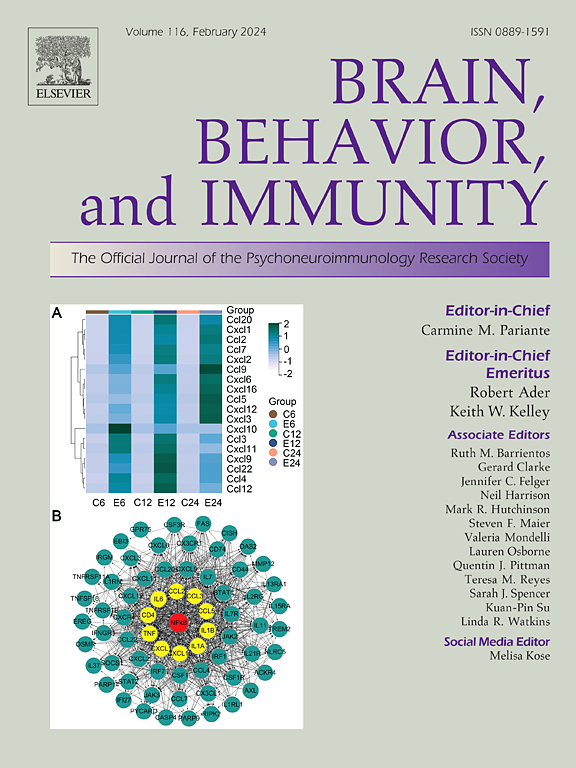Prenatal opioid exposure and maternal HCV infection impair microglia development and function: A patient-specific in vitro model
IF 8.8
2区 医学
Q1 IMMUNOLOGY
引用次数: 0
Abstract
Opioids are a class of pain-relieving drugs known to cross the placental and blood brain barriers, exposing the fetus in utero. Rates of opioid use disorder amongst pregnant individuals in the United States are on the rise, and intravenous routes of opioid administration are highly associated with hepatitis C (HCV) infection. Newborns with prenatal opioid exposure (POE) are more likely to be small for gestational age and have increased rates of neurodevelopmental delay. Microglia are brain-resident macrophages that originate from yolk-sac precursors that play critical role in neurodevelopment. However, our understanding of the impact of POE on microglia maturation and function remains limited due to the scarcity of adequate models. Here, we leveraged a model of induced microglia-like cells (iMGL) derived from umbilical cord blood mononuclear cells to uncover the mechanisms underlying the impact of POE ± maternal HCV infection on microglia morphology, phenotype, function, and transcriptional profiles. Our study revealed that iMGL are closely related to primary microglia. iMGL derived from pregnancies with POE and maternal HCV infection exhibited an ameboid-like phenotype, characterized by smaller area/perimeter and diminished ramifications. This was accompanied by dysregulated expression of key microglia markers, impaired phagocytic capacity, but increased secretion of inflammatory mediators. Finally, transcriptional analysis of iMGL with and without stimulation by LPS revealed that POE ± maternal HCV infection desensitized iMGL to LPS stimulation. This immune tolerance of iMGL in utero was reflected by altered expression of genes important for neurological and fetal development, phagocytosis, and antimicrobial responses with POE ± maternal HCV infection. Overall, these findings highlight the utility of iMGLs as an accessible patient-specific model to study preconditioning and development of fetal microglia and provide insight into mechanisms underlying adverse neurodevelopmental outcomes in newborns with POE in presence and absence of maternal HCV infection.
产前阿片类药物暴露和母体HCV感染损害小胶质细胞发育和功能:一个患者特异性的体外模型
阿片类药物是一类缓解疼痛的药物,已知会穿过胎盘和血脑屏障,暴露子宫内的胎儿。美国孕妇中阿片类药物使用障碍的比率正在上升,静脉注射阿片类药物与丙型肝炎(HCV)感染高度相关。产前阿片类药物暴露(POE)的新生儿更有可能小于胎龄,并且神经发育迟缓的发生率增加。小胶质细胞是脑内巨噬细胞,起源于卵黄囊前体,在神经发育中起关键作用。然而,由于缺乏足够的模型,我们对POE对小胶质细胞成熟和功能的影响的理解仍然有限。在这里,我们利用来自脐带血单个核细胞的诱导小胶质样细胞(iMGL)模型来揭示POE±母体HCV感染对小胶质细胞形态、表型、功能和转录谱影响的机制。我们的研究表明,iMGL与原发性小胶质细胞密切相关。妊娠期POE和母体HCV感染的iMGL表现出变形虫样表型,其特征是面积/周长较小,分枝减少。这伴随着关键小胶质细胞标志物的表达失调,吞噬能力受损,但炎症介质的分泌增加。最后,对LPS刺激和不刺激iMGL的转录分析显示,POE±母体HCV感染使iMGL对LPS刺激脱敏。这种iMGL在子宫内的免疫耐受通过POE±母体HCV感染时神经和胎儿发育、吞噬和抗菌反应重要基因的表达改变来反映。总的来说,这些发现突出了iMGLs作为一种可访问的患者特异性模型的实用性,用于研究胎儿小胶质细胞的预处理和发育,并为POE新生儿在存在或不存在HCV感染的情况下不良神经发育结局的机制提供了见解。
本文章由计算机程序翻译,如有差异,请以英文原文为准。
求助全文
约1分钟内获得全文
求助全文
来源期刊
CiteScore
29.60
自引率
2.00%
发文量
290
审稿时长
28 days
期刊介绍:
Established in 1987, Brain, Behavior, and Immunity proudly serves as the official journal of the Psychoneuroimmunology Research Society (PNIRS). This pioneering journal is dedicated to publishing peer-reviewed basic, experimental, and clinical studies that explore the intricate interactions among behavioral, neural, endocrine, and immune systems in both humans and animals.
As an international and interdisciplinary platform, Brain, Behavior, and Immunity focuses on original research spanning neuroscience, immunology, integrative physiology, behavioral biology, psychiatry, psychology, and clinical medicine. The journal is inclusive of research conducted at various levels, including molecular, cellular, social, and whole organism perspectives. With a commitment to efficiency, the journal facilitates online submission and review, ensuring timely publication of experimental results. Manuscripts typically undergo peer review and are returned to authors within 30 days of submission. It's worth noting that Brain, Behavior, and Immunity, published eight times a year, does not impose submission fees or page charges, fostering an open and accessible platform for scientific discourse.

 求助内容:
求助内容: 应助结果提醒方式:
应助结果提醒方式:


